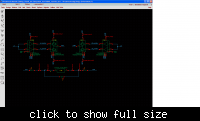fcfusion
Full Member level 4
Hi guys
I'm testing a Class D amplifier output stage and I'm having some troubles with the simulations. The simulation runs fine in the beginning but after a while the output voltage at the load's pins starts to oscillate with very sharp spikes and increases up to several KiloVolts!!! Once it starts to oscillate, the simulation because very slow.
I suspect it is caused by the LC components and 've tried changing timestep, Method=GEAR, GMIN, RSHUNT and all that stuff but the circuits still reaches several kV!!!
The circuit is composed by an H-Bridge and Drivers, a low pass filter and the 8 Ohm load. The H-bridge is driven by an ideal source.
Any help is apreciated

I'm testing a Class D amplifier output stage and I'm having some troubles with the simulations. The simulation runs fine in the beginning but after a while the output voltage at the load's pins starts to oscillate with very sharp spikes and increases up to several KiloVolts!!! Once it starts to oscillate, the simulation because very slow.
I suspect it is caused by the LC components and 've tried changing timestep, Method=GEAR, GMIN, RSHUNT and all that stuff but the circuits still reaches several kV!!!
The circuit is composed by an H-Bridge and Drivers, a low pass filter and the 8 Ohm load. The H-bridge is driven by an ideal source.
Any help is apreciated
